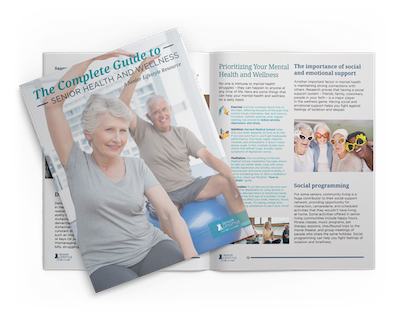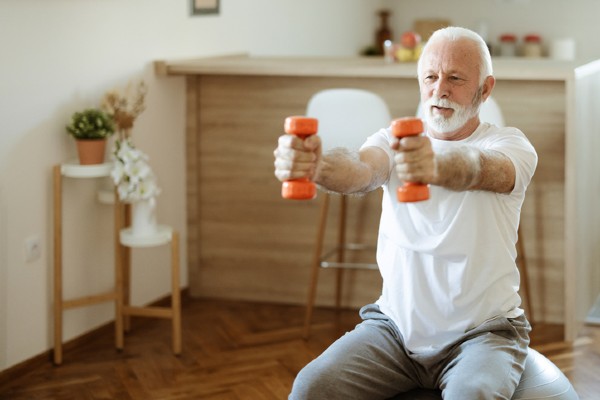Resistance training – also known as strength training – is a safe and effective way for seniors to build strength, support balance, and maintain independence. It can include lifting light weights, using resistance bands, or performing exercises that use your own body weight.
With a few simple moves and a thoughtful approach, resistance training can become part of a healthy routine. In this article, we’ll uncover the benefits, share safe ways to get started, and offer a few easy exercises to try.

Download The Complete Guide to Senior Health and Wellness
The key to living your “best life” as you age? Prioritizing your health. Check out our eBook, “The Complete Guide to Senior Health and Wellness,” to learn about the most important aspects of senior health and wellness.
Download the GuideWhy Resistance Training Matters for Seniors
Staying strong as we age is one of the best ways to keep doing the things we love, whether that’s nature walks, playing games like pickleball, or something else entirely.
Here are a few more reasons why seniors should consider adding resistance exercises to their daily routine.
Preserve Muscle Mass
As we get older, it’s natural to lose some muscle over time through a process known as sarcopenia. Resistance training can help slow this process and, in many cases, reverse it. By keeping muscles strong, seniors can maintain the strength needed for everyday tasks, from getting out of a chair to lifting a grocery bag.
Improve Bone Density
Resistance exercises place gentle stress on bones, which encourages them to become stronger. This helps reduce the risk of bone thinning and fractures, supporting long-term mobility and safety.
Boost Balance and Mobility
Improved muscle strength contributes to better balance and coordination. That means more stability, better posture, and greater ease with walking, climbing stairs, or getting up from a seated position.
Improve Metabolic and Heart Health
Strength training helps regulate weight, support blood sugar levels, and manage cholesterol. When combined with other healthy habits, it can play a role in lowering the risk of certain chronic health conditions.
Support Mental Wellness
Physical activity doesn’t just help the body, it supports the mind as well. Regular strength training is linked to improved mood, sharper thinking, and reduced feelings of stress.
Getting Started Safely
Before beginning any new exercise routine, it’s important to speak with a doctor, especially for people with existing health conditions or who are returning to exercise after a break. A quick conversation can help ensure you’re starting safely.
Here are a few more tips on how to safely begin a resistance training routine.
Start Slow and Focus on Form
The best way to begin is with slow, steady movements using light weights or just your body weight. Practicing proper form helps prevent injury and builds confidence. As strength improves, you can gradually increase the intensity.
Choose the Right Environment
Some people prefer exercising at home using items they already have. Others like the motivation of a group exercise class or a dedicated fitness space. The key is to find a place where you feel comfortable, supported, and encouraged.
Consider a Trainer or Physical Therapist
Working with someone who has experience supporting seniors can make a big difference. Whether it’s one-on-one or in a small group setting, professional guidance can provide peace of mind and help you reach your goals safely.
Beginner-Friendly Resistance Exercises
Here are a few simple exercises to try. Be sure to move slowly, breathe steadily, and stop if you feel any discomfort. Again, we recommend talking with your doctor to identify safe ways to get started and/or connecting with a local fitness program or wellness team.
Chair Squats
Using a sturdy chair, stand in front of it with your feet shoulder-width apart. Lower yourself toward the seat as if you’re going to sit, then stand back up. Try two or three sets of eight to 10 repetitions. This exercise helps build leg and hip strength.
Wall Push-Ups
Stand an arm’s length away from a wall. Place your palms flat on the wall at shoulder height. Slowly bend your elbows to bring your body closer, then push back to your starting position. Try three sets of 10 to 15 repetitions. This strengthens the chest, shoulders, and arms.
Seated Bicep Curls
Sit tall in a chair with a light weight or water bottle in each hand. With your arms at your sides and elbows close to your body, bend your elbows to lift the weights, then lower them back down. Aim for two or three sets eight to 12 repetitions. This exercise strengthens your biceps and forearms.
Standing Calf Raises
Hold onto the back of a chair for support. Raise your heels off the ground so you’re standing on your toes, then slowly lower back down. Try two or three sets of 10 to 15 repetitions to improve lower leg strength and stability.
Resistance Band Rows
Sit in a chair and loop a resistance band around your feet. Holding the ends of the band, pull back with your elbows while squeezing your shoulder blades together. Slowly return to the starting position. Aim for two or three sets of eight to 15 repetitions. This exercise strengthens the upper back and shoulders.
Tips to Stay Motivated
Starting something new is easier when it feels rewarding. Here are a few ways to keep resistance training part of your routine:
- Set small, realistic goals, like increasing repetitions or improving balance.
- Track your progress with a journal or calendar.
- Exercise with a friend or join a group class to stay connected.
- Listen to your body and take rest days when needed.
More Time for Fitness with Senior Lifestyle
Whether you’re looking to move with more confidence, maintain your energy, or simply feel your best, resistance training is a powerful way to support your overall well-being. However, strength doesn’t come from doing something big all at once. It comes from small, steady steps taken each day.
At Senior Lifestyle, our health and wellness teams can help you get started through our regularly scheduled fitness programs and expert insights. Plus, since we take care of everything from maintenance to transportation, you’ll have more freedom to focus on your fitness. Whether you’re looking for Independent Living, Assisted Living, or personalized Memory Care in our Embrace Neighborhoods, you’ll find a place where comfort, care, and connection come together.
Find out more about Senior Lifestyle or schedule a visit today!

